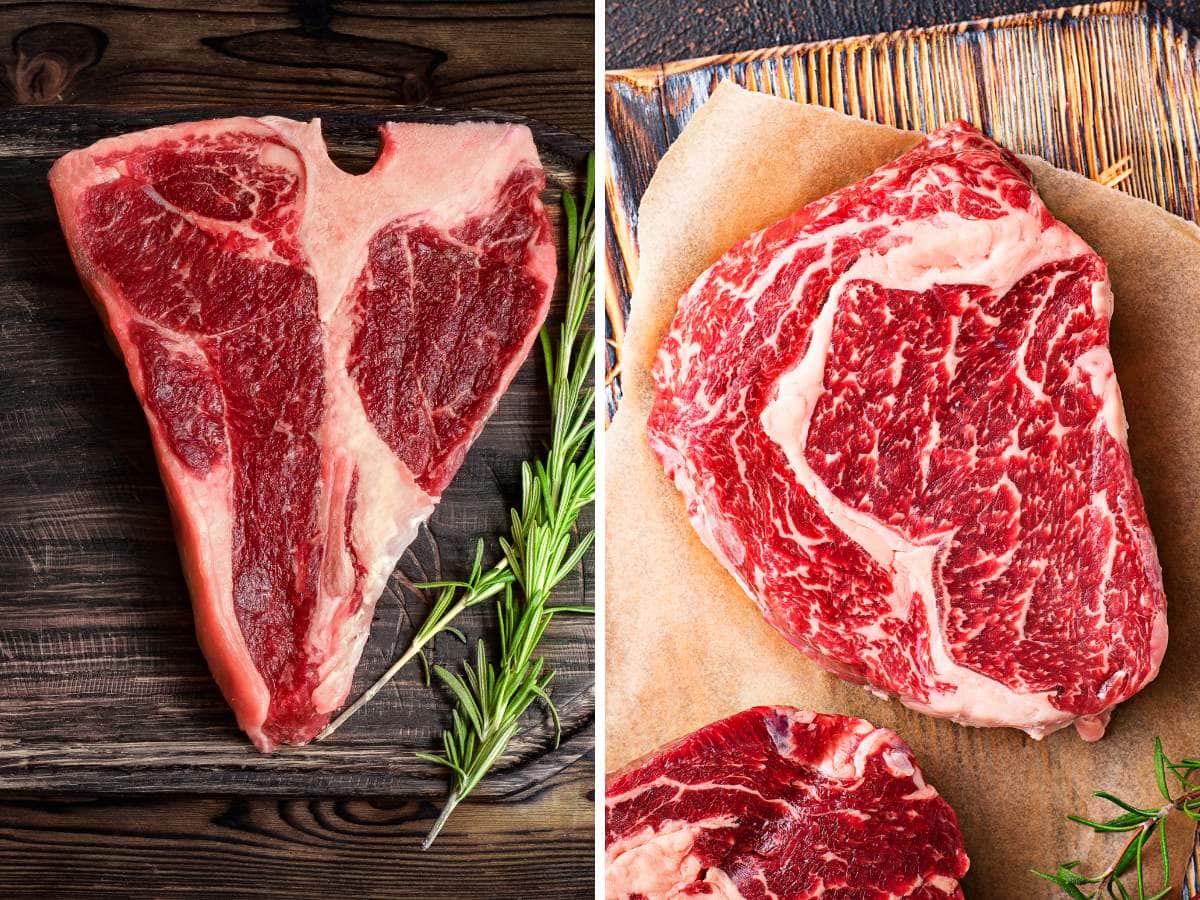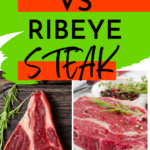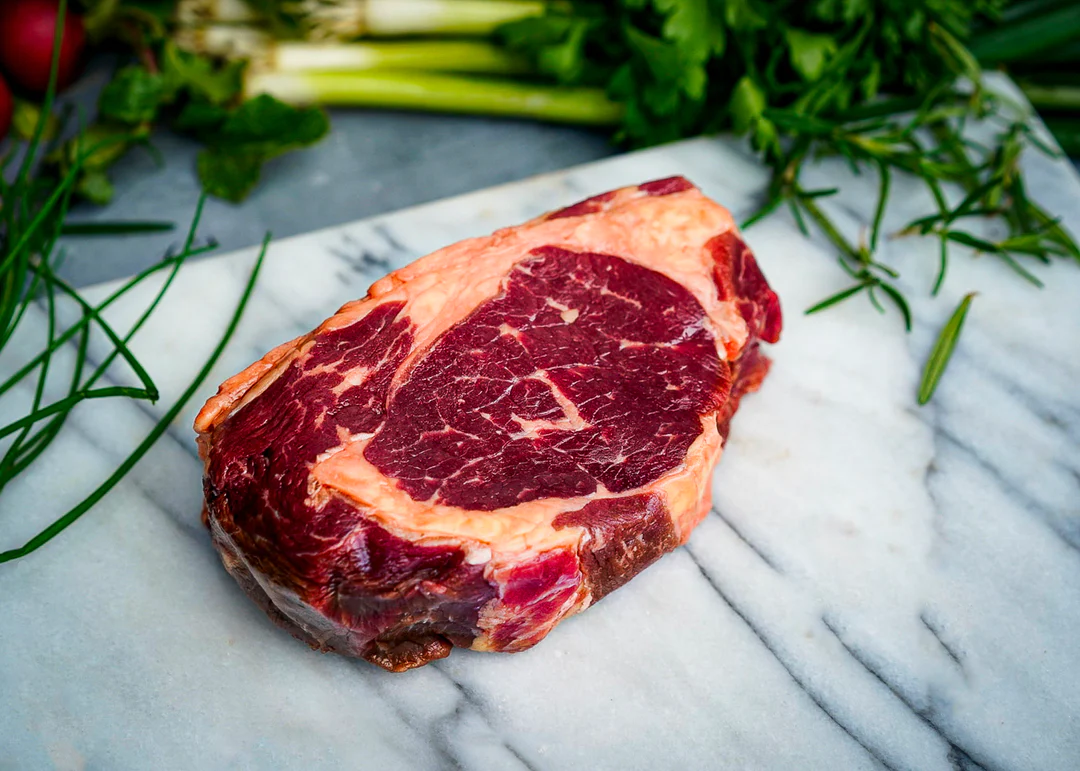Primal Edge Health participates in the Amazon Services LLC Associates Program and other affiliate programs and therefore, may collect a share of sales or other compensation from the links on this page. This comes at no additional cost to you, and all the prices and availability are accurate at the time of publishing.
Ever wonder what makes a good steak so unforgettable? It all boils down to the cut of beef you use. Today, we have two tough (or should I say tender?) contenders: T-bone steak vs. ribeye.
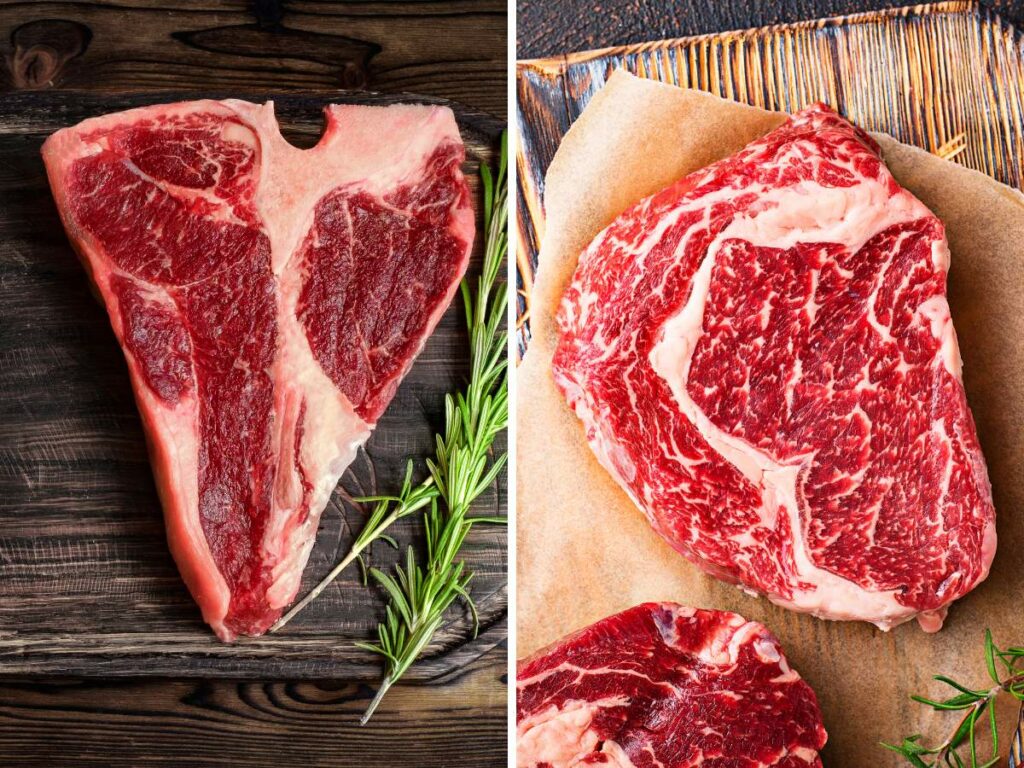

Both of these cuts tend to have big price tags, but one steak might please your palate better than the other. So, how do you make sure you’re getting the most bang for your buck? Let’s find out.
T-Bone Steak vs. Ribeye: A Brief Comparison
T-bone and rib eyes steaks are both considered high-end steaks, and most people find them equally delicious. After all, any steak can be yummy when cooked right. However, there are quite a few differences when you look into these steak cuts further:
Protein Content
Both T-bone and ribeye steaks contain a significant amount of protein per portion. According to the USDA, the average T-bone steak (bone-in, cooked) has about 27g of protein per 100g serving. On the other hand, a typical ribeye steak will have about 19g of protein per 100g.
Fat Content
From a nutritional standpoint, we also need to consider the fat content of these cuts. T-bone steaks trimmed to ⅛-inch fat have about 11.5g of fat per 100g, while ribeyes have 20g per 100g. Both cuts are significant sources of fat that may help you hit your daily goals.
T-bone and ribeye steaks have an excellent amount of marbling, which refers to the small strips of fat within the muscle. It adds that flavor, mouthfeel, and juiciness you’re looking for in a good steak. In fact, marbling can affect the grade, and therefore the price, of your steak.
The USDA has a grading system that assesses the quality of beef, and one of the factors they consider is marbling. USDA Prime is the highest grade a steak can get, given to only the finest steaks. USDA Choice has less marbling than Prime Steaks but is still a high-quality category. USDA Select Beef has the least amount of marbling compared to the other two categories, so it may not be as juicy or flavorful.
Source of the Cut
The part of the cow where the steak comes from makes a huge difference in meat quality. This beef guide from the University of Nebraska-Lincoln gives us a good idea of exactly where these steaks come from.
The T-bone consists of meat from the short loin, separated by a unique T-shaped bone. On one side, you have the prized New York strip, which offers a strong beefy flavor and medium tenderness. On the other is the tenderloin section, which is extremely tender but less flavorful. Fun fact: separating the tenderloin side of a T-bone will turn it into a filet mignon.
Ribeye steaks come from the large end of the rib section of the cow. It contains three to four types of muscles, including two delicious ones known as the spinalis dorsi and longissimus dorsi muscle, both responsible for the rich beef flavor and juicy texture of ribeye.
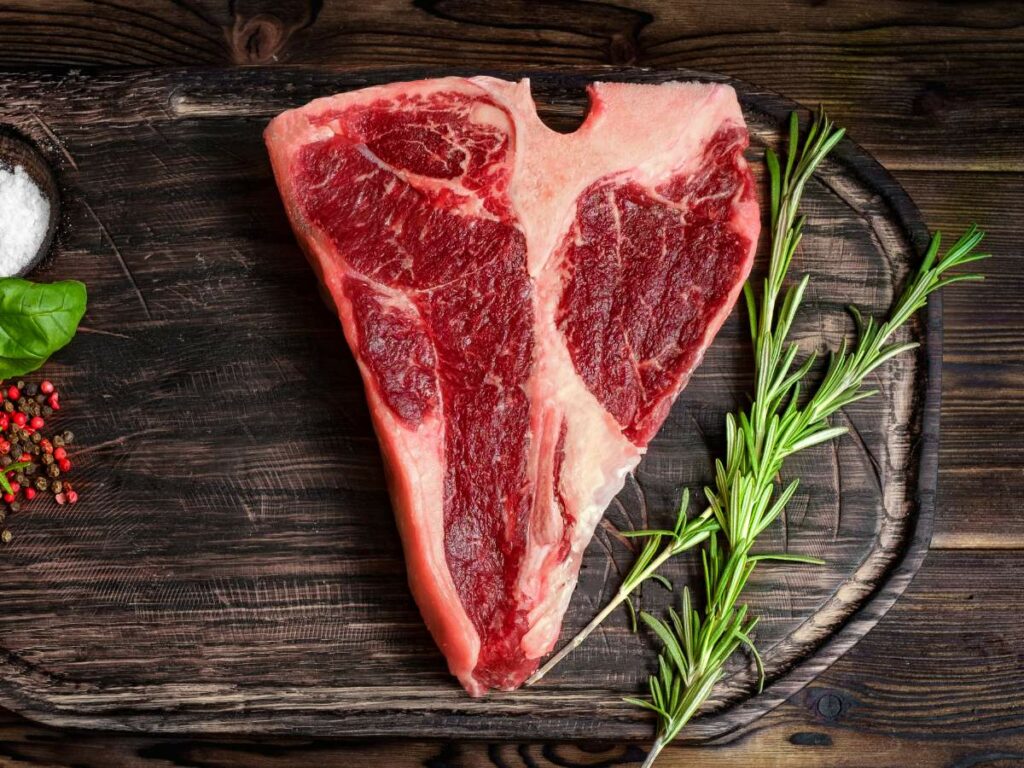

Appearance, Size, and Weight
At first glance, you can clearly see the difference between a T-bone and a ribeye steak. The former will have a characteristic T-shaped bone, while the ribeye steak typically comes boneless. Bone-in ribeye steaks are available at most butcher shops, but the bone doesn’t really make a difference flavor-wise. Another way you can distinguish a boneless ribeye steak is the large streak of fat separating the spinalis dorsi and longissimus dorsi.
On average, a T-bone steak weighs around 16 to 18 ounces, including the bone, and is usually eight inches long to three inches wide at its widest point. A boneless ribeye steak is around 15 to 17 ounces, six to eight inches long and five inches wide at the widest point.
Cost
T-bone and ribeye steaks are popular cuts and generally expensive due to their supreme quality. Plus, their USDA grading will affect the price.
In general, however, ribeye steaks are more expensive than T-bones when you compare prices by the pound. The ribeye steak doesn’t have a huge bone in the middle, meaning you’re getting pure meat. Plus, ribeye steaks tend to be more diverse and flavorful.
Prices vary in different locations, but you can research the USDA retail report for beef to see the average prices for these cuts of steak. Check out these budget tips to learn how you can get the most out of your money when buying meat.
Which is the Better Steak For You?
Some steak lovers will tell you that the ribeye is the best cut of steak, but others would say that the T-bone is much more delicious. I say it all depends on a lot of factors, including your personal preferences, nutritional goals, and budget.
Maybe you’re thinking of picking up a nice steak the next time you go to the grocery store, or perhaps wondering what you should order at a steak house. Whatever the case may be, understanding the main differences between a T-bone steak vs. ribeye can help you make the right decision. Here’s what you should know about these different cuts at a glance:
| T-Bone | Ribeye | |
| Nutritional Value | Higher protein content, lower fat content | Lower protein content, higher fat content |
| Flavor Profile and Juiciness | More flavorful on the strip part | Rich and flavorful overall, juicier than T-bone because of its high-fat content |
| Tenderness | More tender on the tenderloin part | Very tender |
| Cost | Expensive, but generally less expensive than ribeye | Very expensive |
| Average Size and Weight | Typically eight inches long and two to three inches wide; weighs around 16 to 18 ounces | Usually six to eight inches long and five inches wide at its widest point; weighs around 15 to 17 ounces |
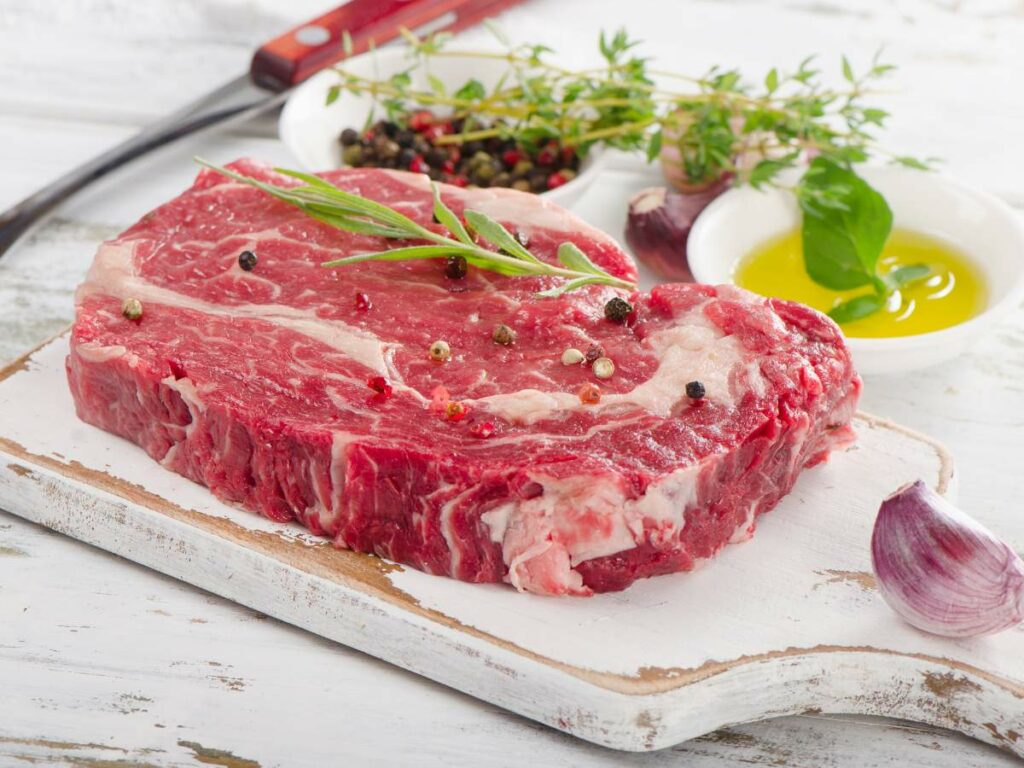

The Best Preparation Methods for Each Cut
The type of cut you choose is the most important part of getting the perfect steak, but that’s not all. How you cook your meat also matters a great deal. Here are the best cooking methods for each steak type:
T-Bone Steak Cooking Methods
- Reverse sear: A T-bone or porterhouse steak will come out well with a reverse searing method, primarily due to their high marbling content. This process involves slow-cooking the steak in an oven and finishing it off on a skillet to bring out its natural flavors and maintain the meat’s natural tenderness.
- Grilling: Cooking your T-bone steaks on a grill gives them a delicious, slightly charred outer crust while keeping the insides tender. Add a rich buttery flavor with a dab of rosemary garlic compound butter.
- Smoking: If you have a smoker, consider testing it out on a T-bone steak. This method further tenderizes the steak and incorporates that smokey flavor that goes great with keto-friendly sides.
Ribeye Steak Cooking Methods
- Pan-searing: The bone in a T-bone steak may prevent the meat from coming into full contact with the pan. On the other hand, a rib eye steak is perfectly flat and will cook evenly with a pan-sear. Use a perfectly seasoned cast iron skillet for an optimum balance of flavor.
- Sous vide: Ribeye is the best steak for the sous vide method. Sous vide involves vacuum-sealing food and cooking it in a water bath. The controlled temperature ensures your steak is cooked evenly, while the vacuum seal prevents the leaching of the beef’s natural flavors.
- Grilling, smoking, and reverse searing: Ribeye steaks are versatile and will cook well in the grill, smoker, and oven. In my experience, reverse searing is the best way to cook a juicy, flavor-bomb of a steak.
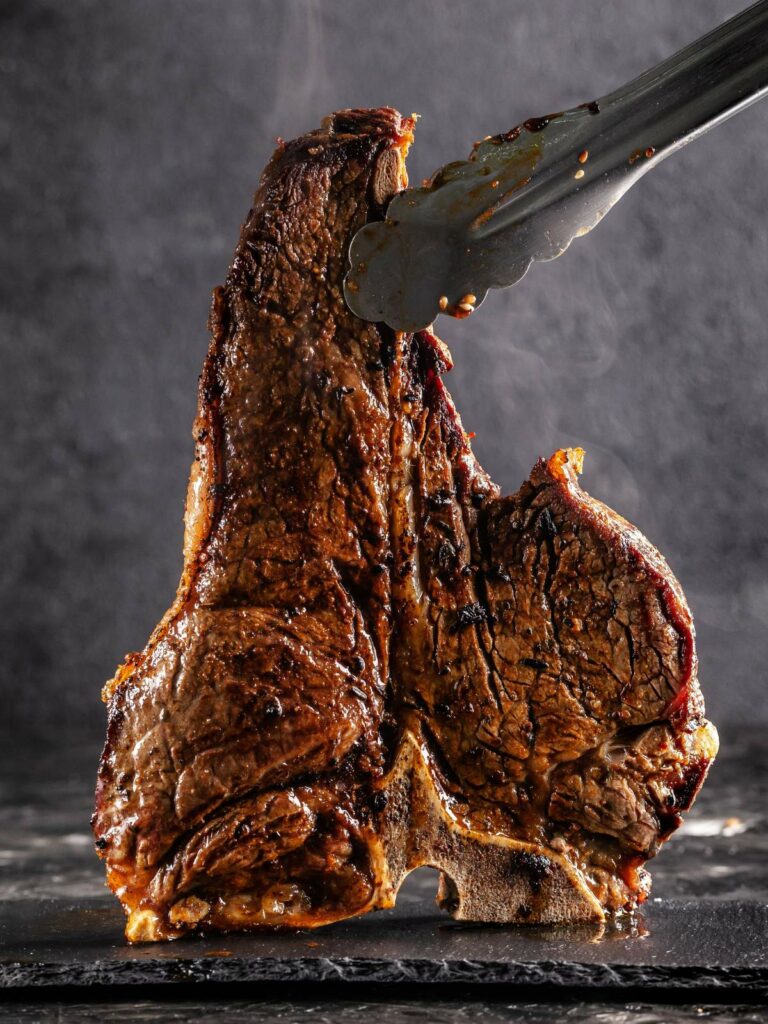

Cooking Tips for the Perfect Steak
Learning the art of cooking meat doesn’t have to be difficult. While it may take you a few tries to get the doneness, flavor, and texture you’re looking for in a steak, you don’t have to be a professional chef to do it. Here are some helpful tips:
- Don’t cook a cold steak. Defrost your steaks overnight, take them out of the fridge, and let them reach room temperature before cooking. Room-temperature steaks are more likely to cook evenly.
- Dry your steak. Pat your steaks dry with paper towels before cooking. Doing this will get rid of extra moisture that might produce steam and prevent the salt from melting. Both reduce the chances of a good sear.
- Ease up on the seasonings. T-bone and ribeye steaks are rich in natural flavors, and adding too many seasonings can mask them. At most, a pinch of mineral-rich salt, black pepper, and some fresh herbs should do the trick.
- Choose the right oil. Cooking a steak requires a very high heat, so choose an oil with a high smoke point, such as avocado oil, clarified butter, tallow or lard.
- Opt for a
cast iron skillet . Cast iron skillets hold a lot of heat and ensure even cooking, making them a popular choice for all kinds of steaks. - Use a meat thermometer. How do you check if your steak is done? More experienced steak enthusiasts can tell just by looking at it or gauging the cooking time. If you’re a beginner at cooking steaks, I highly recommend using a meat thermometer to read the internal temperature for desired doneness. For example, a medium rare steak should reach a temperature of 130 to 135F (54 to 57C).
- Allow your meat to rest. During the cooking process, steaks will form a crust that locks juices inside the meat. Let your meat rest for at least five to ten minutes to avoid losing all that moisture.
- Cut against the grain. Look for the direction the muscle fibers move across your steak to find the grain, which will look like long lines that run through your meat. Then, you want to cut vertically parallel to these fibers. What this does is break up the steak’s muscle fibers, making the meat easier to chew.
Final Thoughts
When comparing a T-bone steak vs. ribeye, it can be pretty hard to choose a clear winner. Both of these steaks are high-quality, delicious, and oh-so tender. Plus, they’re great sources of protein and fat.
So, which steak is superior? The answer depends on your personal preference and, honestly, your taste buds. If you want the tenderness of tenderloin and the rich flavor of a New York strip steak, go for the classic T-bone steak. Don’t mind splurging on a more tender and flavorful cut? Opt for the ribeye. Regardless of what you choose, both of these high-value steaks will make for a mouth-watering main course for dinner dates and special occasions.





